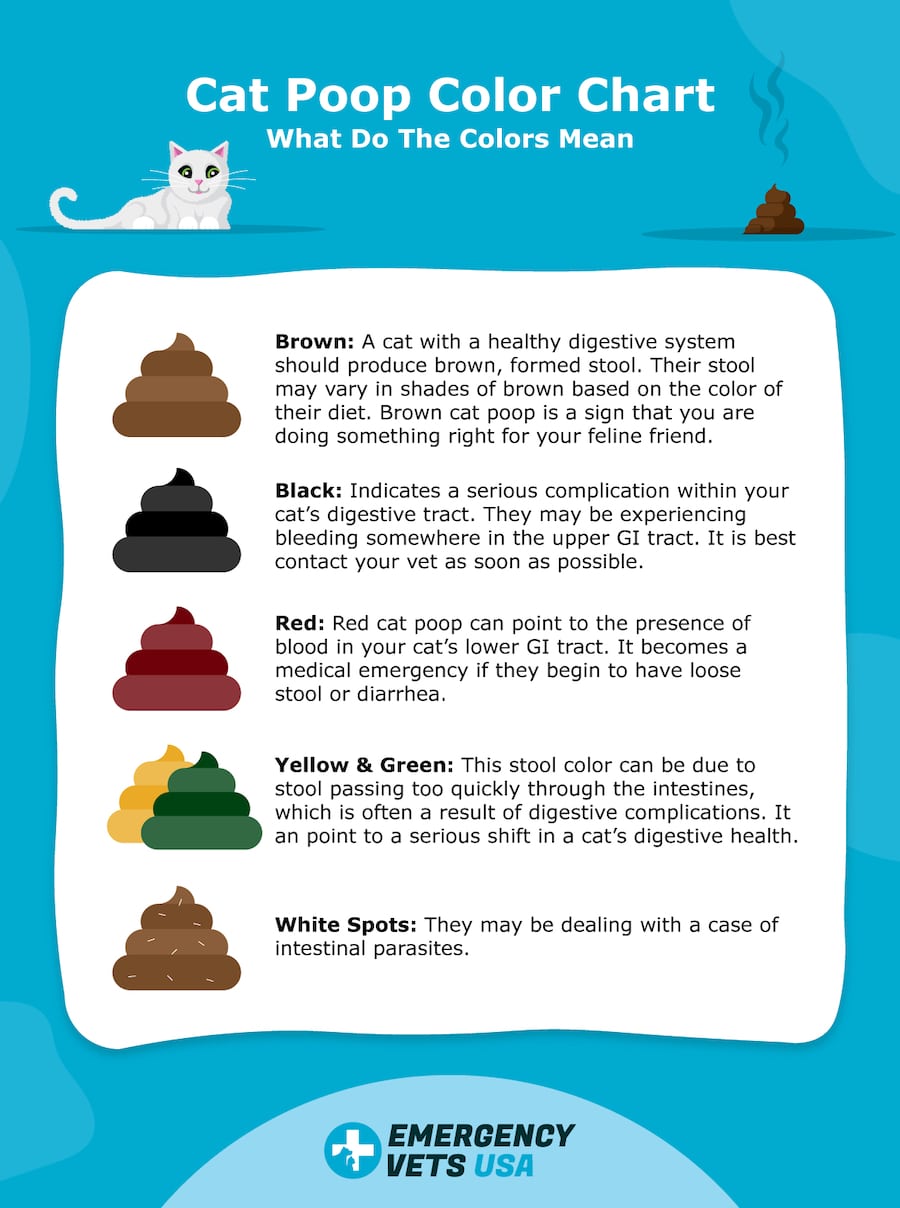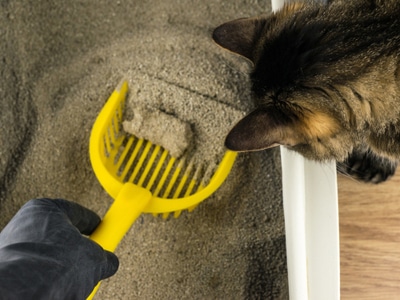Cat Poop Color Chart – What Do The Colors Mean
Your cat’s poop color is more significant than you may think.
Stool condition is an incredible peak into their overall health, and can offer a few hints of what could be wrong with your furry friend.
So what do certain stool colors mean for a cat?
In this article we will discuss our detailed cat stool color guide, and help you understand the importance of stool health in your feline companion.
The Importance Of Examining Your Cat’s Poop
Before we discuss each poop color in our furry friends, let’s first talk about the importance of examining your cat’s stool in general.
A healthy gut and digestive tract should create formed brown stool, meaning anything that falls outside of this description should catch your attention.
Many medical complications in cats can affect their digestive health, and may even be the first clue of developing illness.
Cleaning your cat’s litter box gives you the perfect opportunity to stay on top of their digestive health, and make note of any changes in their stool color or consistency.
Fast action in many situations can offer your cat the best chance at a swift recovery, and may even introduce you to a developing complication you would not have noticed otherwise.
Staying on top of your cat’s poop appearance is more important than you may think.

Cat Stool Color Guide
While examining your cat’s stool may seem a bit odd, it is a great way to ensure that your cat is getting everything they need.
Changes in their stool color can be a sign that it’s time to visit your veterinarian.
They can help you figure out what could be causing certain health symptoms.
To help you better understand your feline friend, let’s discuss each poop color in cats and what it can mean for their health.
Brown Cat Poop
A cat with a healthy digestive system should produce brown, formed stool.
Their stool may vary in shades of brown based on the color of their diet, and should be firm yet pliable in texture.
Not only should their stool be brown in color, but the color should remain consistent as long as their diet remains the same.
While most shades of brown poop can be normal, any abrupt changes should warrant a trip to the vet.
Brown cat poop is a sign that you are doing something right for your feline friend.
As long as their stool is formed and free of any abrupt changes, they are likely getting what they need in their daily diet.
Just be sure to keep an eye on their stool for any future changes, and keep up the good work!
Black Cat Poop
Black cat poop can point to a serious complication within your cat’s digestive tract.
If your cat’s stool is black in color, they may be experiencing bleeding somewhere in the upper GI tract.
The upper GI tract consists of the mouth, stomach, and small intestine, each of which can be damaged by situations ranging from intestinal parasites to toxicities.
Blood will often have a black and tarry appearance once it has been digested, coating the poop each time the cat passes stool.
Black cat poop in our furry friends is a serious symptom that should always warrant a trip to the vet.
Internal bleeding can be life threatening if it is not addressed as soon as possible, and requires veterinary assistance to get to the source of the problem.
If your cat ever experiences black stool, it is best to contact your vet as soon as possible.
Red Cat Poop
Red cat poop can point to the presence of blood in your cat’s lower GI tract.
While this may not be as serious as the presence of black stool, it should still warrant concern.
Red streaks or a red tint to your cat’s poop can mean that there is bleeding in the lower GI tract.
This blood has not had the chance to be digested yet, leading to the presence of a bright red tint versus black stool.
Our cats can experience bleeding in their lower GI tract for many reasons.
This can be due to irritation within the intestines, straining to defecate, changes in their diet, and more.
An occasional blood streak in their stool is not always tied to a major medical complication, and may come and go as time goes on.
However, if you see blood in their stool more than once, along with any other changes in their behavior, we suggest contacting your vet for further advice.
Red cat poop becomes a medical emergency if they begin to have loose stool or diarrhea.
This can point to serious GI upset in our feline friends, and requires medical intervention to correct.
Yellow & Green Cat Poop
Yellow and green cat poop should be a serious concern for cat owners.
This stool color can be due to stool passing too quickly through the intestines, which is often a result of digestive complications.
Not only can this point to possible complications with organs that play a role in digestion (liver and gallbladder), this can point to infection within the digestive tract as well.
Yellow or green cat poop can point to a serious shift in a cat’s digestive health.
No matter the cause behind this change, it is best to contact your veterinarian and get to the bottom of it.

White Spots In Cat Poop
If you see any white spots in your cat’s poop, they may be dealing with a case of intestinal parasites.
This is especially common in cats that spend some time outdoors, as well as cats that are recently adopted.
Cats can be exposed to intestinal parasites in the soil that they come in contact with, along with fleas that make their way into their fur.
Not only can they get worms from the world around them, but from other infected cats as well.
Each intestinal parasite may look a little different when seen in your cat’s stool.
For example, tapeworms may have a rice-like appearance, while round worms may look more like spaghetti noodles.
No matter which type of worm you think you may see in your cat’s stool, it is time for a trip to the vet to banish these critters for good.
Healthy Vs Unhealthy Cat Poop

Not only is the color of your cat’s poop important to be aware of, it is also essential to understand what healthy poop looks like in our feline friends.
Brown cat poop may not be ideal if it sports an unhealthy texture, making it necessary to examine every aspect of their stool as a whole.
Each time you scoop your cat’s litter box, it is best to keep a few key points in mind.
To help you stay on top of their stool health, let’s list a few characteristics of healthy and unhealthy cat poop.
Healthy
- Firm yet pliable
- Easy to scoop in the litter box
- Uniform in color
- Mostly unsegmented
Unhealthy
- Runny or difficult to scoop
- Changes in color
- Hard or dehydrated
- Segmented, hard balls of poop
If your cat is experiencing any of the unhealthy characteristics of stool, it is best to contact your veterinarian for further advice.
A cat’s poop appearance can be a peak into their overall health in many ways.
If you have questions or are concerned with your cat’s poop color, please call your local veterinarian for assistance.

My name is Amber. I am a dedicated animal lover that turned my passion into my career. I am a Licensed Vet Tech with 12 years of experience in veterinary medicine, but I recently took my career online to help spread accurate information on animal care. With how vast the online world is, I have a strong desire to ensure that the reader always walks away with helpful pet advice. With the experience I’ve gained from my time in this field, I have been able to travel the world, offering my services to as many animal rescues as I can find. If I am not at my laptop, or back home visiting family, you can find me somewhere in the world, cuddling every furry friend that I can find! More About Us
